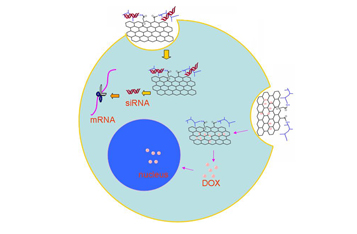|
Recently, a research team led by Professor ZHANG Zhijun at Suzhou Institute of Nano-tech and Nano-bionics (SINANO), Chinese Academy of Sciences, has made progress in development of drug and gene delivery vectors based on graphene oxide (GO) and other nanomaterials. The researchers studied controlled loading and targeted delivery of two anticancer drugs, doxorubicin (DOX) and camptothecin (CPT) by functional GO. They found that the combined loading of DOX and CPT displays much better therapeutic efficacy than that of a single drug. The work was published in Small (2010, 6, 537-544) and ranked among the most accessed articles in January 2010. They further studied delivery of siRNA and DOX by polyethylenimine (PEI) -grafted GO. They demonstrated that sequential delivery of siRNA and DOX by PEI-GO leads to significantly enhanced anticancer efficacy (Small, 2011, 7, 460-464). The work was highlighted by Wiley-VCH MaterialsViewsChina. Most recently, the group demonstrated that PEI-GO can be used as an efficient gene delivery vector (Journal of Materials Chemistry, 2011, in press, DOI:10.1039/C1JM10341E).
The group also designed and synthesized a novel magnetic drug delivery system composed of DOX-conjugated Fe3O4 nanoparticle core and a PEG-functionalized porous silica shell. The presence of the porous silica shell not only provides a protective layer for drug molecules and the magnetic nanoparticles, but also facilitates magnetically guided drug delivery and controlled release of the drug from the nanocarrier (Chem. Comm. 2010, 46, 8633-8635). This work was selected as one of the top 10 most read articles from Chem. Comm. in October, 2010.
In addition, Prof. ZHANG and his colleagues developed a convenient strategy for preparation of VP6, a rotavirus capsid protein, in large scale from E.coli, and further demonstrated the feasibility of the VP6-based virus like particles, a kind of biological nanoparticles with excellent biocompatibility and biodegradability, for targeted drug delivery (Bioconjugate Chem. 2011, 22, 346-352).
The work was financially supported by National Natural Science Foundation of China (NSFC), National Program on Key Basic Project of China (973 Program), Chinese Academy of Sciences (CAS) and Jiangsu Provincial Fund for Natural Sciences.
 |
|
Schematic illustration of sequentialdelivery of siRNA and DOXusing PEI–grafted graphene oxide.
Image by Divisionof Nanobiomedince, SINANO |
|

